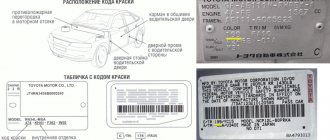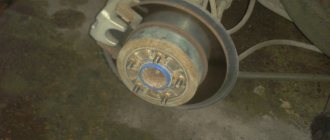In the Toyota Camry XV40, the engine cooling system (ECS) includes a radiator, fan, heat exchanger, centrifugal pump, thermostat and expansion tank. Failure of one of the system components will most likely lead to engine failure, which can lead to expensive repairs.
Therefore, you should regularly monitor the condition of the SOD and change the antifreeze in a timely manner, and it must be of exceptionally high quality. See the photo for how to replace coolant on a Camry V40.
Replacing antifreeze Toyota Camry XV40
In the Toyota Camry XV40, the engine cooling system (ECS) includes a radiator, fan, heat exchanger, centrifugal pump, thermostat and expansion tank. Failure of one of the system components will most likely lead to engine failure, which can lead to expensive repairs.
Therefore, you should regularly monitor the condition of the SOD and change the antifreeze in a timely manner, and it must be of exceptionally high quality. See the photo for how to replace coolant on a Camry V40.
When should coolant be changed?
The volume and quality of antifreeze are characteristics that affect the technical condition of a vehicle engine. It is important to monitor the level and condition of antifreeze in order to make timely adjustments. Coolant replacement is required in the following cases:
- The presence of metal shavings or dirt in the liquid;
- The appearance of turbidity or sediment formation;
- The occurrence of chips or scale inside the motor space;
- During a technical inspection with a refractometer;
- If the results on the diagnostic test strip are appropriate.
It is also necessary to change the coolant after a major engine overhaul or the expiration date of the antifreeze. It is recommended to change antifreeze every five years or after 250 thousand kilometers.
How much does it cost and what kind of antifreeze to use?
The manufacturer developed a special antifreeze “Toyota Super Long Life Coolant”.
For a complete replacement, you can also use other coolants, product code LLC01236, a four-liter canister will cost 820 rubles. Bottle with a volume of 1 liter, catalog number LLC33145, price – 330 rubles. Patron “Antifreeze”, with the article number AFRED1PATRON. The price of a 1-liter canister, product code AFRED1PATRON, will be 240 rubles, and a five-liter canister with product code AFRED5PATRON will be 560 rubles.
Also, during the process of replacing antifreeze, you may need to replace the radiator cap. The original cover from Toyota, product code 1640131520 costs 780 rubles. A number of replacements “to match the original” are available: Masuma MOX202 – 170 rubles, Gates RC134 – 460 rubles, Metalcaucho 03605 – 150 rubles.
Prices are indicated for autumn 2017 for Moscow and the region.
How to dilute antifreeze
To dilute the concentrate, deionized water is used, which does not have a negative effect on the components of the reagent. It is allowed to use distilled water (produced for preparing electrolyte). It is prohibited to mix a solution based on tap water, since the resulting material does not meet the manufacturer’s requirements and is subject to accelerated degradation with the formation of dense sediment on the walls of the cooling system.
How to change antifreeze on a Toyota Camry XV40 with your own hands
According to the maintenance regulations, the first coolant replacement occurs at 160,000 km, and then the interval is reduced to 80,000.
Replacement instructions:
What will you need for replacement?
To replace the coolant on a Toyota Camry XV40, turn off the running engine and let it cool. Place the car on a flat horizontal surface and remove the lower engine mudguards.
In order to relieve pressure in the cooling system, slowly turn the cap of the expansion tank counterclockwise.
Open the expansion tank cap without disconnecting the steam hose from it. If necessary, remove the expansion tank and wash it.
We go down, place a container under the drain valve of the radiator of the cooling system, located in the lower radiator tank, unscrew the drain valve plug 2-3 turns, put a rubber hose on the drain spout, and drain the liquid.
Flush the cooling system, fill the system with water through the radiator filler neck to the level of the steam pipe.
We start the engine and let it run until the electric fan turns on. Stop the engine and drain the water through the radiator drain. We flush the system until clean water comes out.
We prepare the coolant for replacement; to do this, take antifreeze concentrate and mix it with distilled water in a ratio of 50 to 50.
Fill the radiator with coolant to the level of the steam pipe. We start the engine and warm it up to operating temperature. We check the level in the radiator, if necessary, add antifreeze. We tighten the radiator cap.
Add coolant to the expansion tank to about. We start the engine and check the supply of warm air.
Source
Secrets and life hacks: extending the life of your car
It is necessary to pour antifreeze only into a switched off engine. It is also recommended to let the engine cool to the optimum temperature - opening the valve on the expansion tank when the engine is hot can cause a breakdown in pressure, resulting in scalding of the heated fluid. All drain plugs on the crankcase must be opened very carefully and slowly, gradually releasing the internal pressure.
Note! Before adding a new type of antifreeze, you must completely drain the old one and flush the car engine. This procedure will remove the remnants of old antifreeze and eliminate the protective oxidative layer on the metal surface.
You need to pour the flush into the engine, warmed up to operating temperature, so that the thermostat in the system opens and the flush begins to circulate through the cooling system. Due to the engine volume of 2.4 liters, about 7-8 liters of flushing fluid will be required.
Remember, timely replacement of antifreeze will significantly extend the life of the engine. Regular diagnostic checks and careful car care will ensure long and comfortable operation of the Toyota Camry. Protect your vehicle from breakdowns and overloads!
Instructions for replacing coolant
One of the main points in replacing antifreeze is the choice of the product itself. You shouldn't skimp on this. The cost of high-quality refrigerant is from 1,500 rubles and more per 10 liters. When purchasing you should pay attention to:
You can replace antifreeze on a Toyota Camry at a car dealership or do it yourself. If you decide to change it in the salon, then take care of choosing and purchasing antifreeze yourself to be sure of the quality of the product. If you decide to change the refrigerant yourself, then first read the manufacturer’s instructions and take into account all safety precautions, cool the machine before changing, put on a work uniform and gloves. So, you will need 25 liters of water, 6 liters of antifreeze and a tray. The composition of the refrigerant should also be taken into account. There are ready-made cooling liquids. And there are concentrates. To dilute the concentrate, you must strictly follow the instructions for use on the packaging; most often it is diluted in a ratio of 50x50.
Sequencing:
Repair equipment
To carry out maintenance you will need:
- LLC or SLLC concentrate (the volume depends on the capacity of the cooling system, taking into account the dilution of the material with water in a ratio of 1:1);
- deionized water for preparing antifreeze;
- distilled water for flushing (the volume depends on the capacity of the radiators and the number of cleaning cycles);
- a special reagent for removing deposits from the internal surface of pipelines;
- containers for collecting waste material;
- a rag for wiping spilled solution and removing traces of dirt from plugs and drain taps.
What to do if air gets into the cooling system?
If, when replacing antifreeze in a Toyota Camry, air gets into the cooling system, you must allow the engine to warm up well so that the radiator fan turns on. You should operate the pedal for about 5 minutes. The air itself will leave through the exhaust lines from the cooling system. In Toyota Camrys, the air leaves on its own and this is a big advantage when replacing coolant.
You can replace antifreeze yourself; you don’t need special tools, but you need to be prepared with information:
Source
Cooler properties
During operation, the coolant temperature reaches and sometimes exceeds 100 degrees, and during idle time it is compared with the ambient temperature. The effective functionality of the Toyota Camry cooling system, as well as the durability of the V50 power unit, depend directly on the quality of the antifreeze, which must meet the following requirements:
- mobility;
- high thermal conductivity and heat capacity;
- low crystallization and expansion temperature coefficient;
- the substance must have anti-corrosion properties and not corrode rubber elements.
How to drain antifreeze from a Toyota Camry engine block
The engine coolant must be replaced for the first time after 160,000 km of vehicle mileage. Subsequently, replace every 80,000 km of vehicle mileage.
Selecting the coolant type
Using unsuitable coolants may damage the engine cooling system.
Be sure to use "Toyota Super Long Life Coolant" or a similar high quality ethylene glycol type fluid that is free of silicates, amines, nitrites and borates and is formulated with long life hybrid organic acid technology (coolant). based on hybrid organic acids with long service life is a combination of organic acids with low phosphate content).
Toyota Super Long Life Coolant is a mixture of 50% coolant and 50% deionized water.
This coolant provides protection down to temperatures of around -35°C.
We install the car on a lift or inspection ditch
Removing the lower engine mudguards
Turn counterclockwise and remove the radiator cap
Open the expansion tank cap without disconnecting the steam hose from it
We place a container under the drain valve of the radiator of the cooling system, located in the lower radiator tank
Unscrew the drain valve plug 2-3 turns and drain the liquid
After this, place a container under the cooling system drain tap located on the left side of the cylinder block
Unscrew the drain valve plug 2-3 turns and drain the liquid
Hand tighten the plugs of both drain valves
If the expansion tank is very dirty, remove it and wash it with water.
We flush the cooling system; to do this, fill the system with water through the filler neck to the level of the steam pipe
We start the engine and let it run until the electric fan turns on.
Stop the engine and drain the water
We flush the cooling system until clean water begins to drain.
After this, fill the engine cooling system by slowly pouring coolant into the radiator to the level of the steam pipe
We start the engine and warm it up to operating temperature (before turning on the fan). As air leaves the system, add coolant to the radiator. The fan will turn on 3-5 times until the air is completely released.
We tighten the radiator cap and add coolant into the expansion tank to the “F” mark. After this, stop the engine and let it cool down.
We check the coolant level and, if necessary, add it to the expansion tank to the “F” mark.
When the engine is running, you need to monitor the coolant temperature according to the indicator
If the arrow reaches the red zone and the fan does not turn on, turn on the heater and check what kind of air passes through it.
About miscellaneous...
Rules of communication in the forum
| Before you ask a question! How to correctly ask questions in the forum and use site materials. |
| Moscow time 21:25:53 | Your local time | Vladivostok time 04:25:53 |
| Author: Valentin Palych (—.tis-dialog.ru) Date: 01-07-20 01:35 Filled with red G12, I changed it a long time ago when I bought it in 2008. I'm thinking of buying a G12+ Is it worth flushing the cooling system? It seems like a good and understandable thing, but I’m afraid the chemistry will partially dissolve the jacket of deposits, and small pieces will then clog the radiator of the stove. Does anyone have a sad experience, such as flushing and clogging the radiators? |
| Author: John Zaitsev (85.26.164.—) Date: 01-07-20 01:44 Where does the sediment jacket come from in the system? You're not driving on sea water. ) If it’s all the same, then put a plumbing filter in the supply pipe of the stove, and you drive in the summer. If something is flying in the system, you will see it. |
| Author: Valentin Palych (—.tis-dialog.ru) Date: 01-07-20 01:57 Then the question is, if there are no deposits, then how to rinse? Or rather, salt the old antifreeze, fill it with distilled water, pump it for 5 km, salt it, and fill it with new antifreeze, is that enough? Or should I rinse it first, specially for flushing cooling systems? |
| Author: John Zaitsev (85.26.164.—) Date: 01-07-20 05:10 Valentin Palych wrote: > Then the question is, if there are no deposits, then how to rinse? Firstly, who said that it is necessary to rinse? Secondly, they wash it when it is visible to the naked eye that there is some kind of crap in the system. Depending on its composition, the appropriate agent is used. > Or rather, salt the old antifreeze, fill it with distilled water, pump it for 5 km, salt it, > and fill it with new antifreeze, is that enough? You can take it for a drive, let the engine cool down a little (to avoid heat stroke), drain the coolant into a basin, and see if some crap is drained with it. According to Feng Shui, washing should be done with a forced flow while the machine is standing. For as soon as the motor stops, and if something flies in it, then this something immediately settles. Therefore, it is advisable to perform flushing with the engine running with an external filter connected. > special flushing of cooling systems? I don’t know what you have in store there. |
| Author: Valentin Palych (—.tis-dialog.ru) Date: 01-07-20 05:24 Thanks, John. In the evening I went to the car oil store and bought 1.5 liters. concentrate G12 I know the seller, he is a very competent guy, he has been working in the store for many years, he understands the issue. He said that in the fall he was left without a stove and washed the system on his car with some kind of special chemical, acidic or alkaline, I don’t know. Within a month, the mesh filter at the inlet of the heater radiator became clogged, I removed the dashboard and washed the heater mechanically. I decided to rinse with water only. The seller advised, since he hasn’t changed it for 12 years, fill it now with cheap G12, it will wash everything out and absorb dirt in six months, and before winter, change it to an expensive analogue G12 certified for Toyot TANIKAWA YUKA KOGYO “TCL” LLC, also red. |
| Author: UNK (85.173.31.—) Date: 01-07-20 08:17 I’m driving a RAV-4 2008. I only top up the 2AZ engine with red, I have never completely changed or washed it and I don’t plan to wash it. I don’t understand what kind of deposits there can be if you constantly pour antifreeze, it’s not water. |
| Author: Denis Novokuznetsk (89.113.140.—) Date: 01-07-20 15:12 I would recommend antifreeze Kyk Long Life Coolant 54-004, concentrate 4 liter canister, dilute with 3 liters of water, it should be enough for a Camry (for a right-handed Camry with a V6 engine is enough) |
| Author: shustry (—.pool.tolcom.ru) Date: 01-07-20 15:37 I think there is no need to rinse. From the word, absolutely! It’s like the power system. They pour the cleaner into the tank and get clogged nozzles. Just drain - how much will drain from the radiator, from the block and fill in a new one. Moreover, the Camry is filled with antifreeze, not antifreeze! |
| Author: HUNTER-1 (—.pppoe.nsk.ertelecom.ru) Date: 01-07-20 15:38 If the antifreeze didn’t go anywhere, you didn’t add water from the river, the engine didn’t warm up - you don’t need to wash anything, it’s not necessary, the best is the enemy of the good. Drain, fill, don’t look for problems where there are none and drive with pleasure. |
| Author: fedot68(Kaluga) (—.broadband.corbina.ru) Date: 01-07-20 15:48 nimble wrote: > Moreover, the Camry is filled with antifreeze, not antifreeze! Before farting in a puddle, I advise you to look in the service book of the same Camry about the recommended coolant. How do classes of antifreeze differ? I. Still, I really want to know - since when did TOSOL antifreeze cease to be an ordinary antifreeze based on ethylene glycol class G-11??? |
| Author: fedot68(Kaluga) (—.broadband.corbina.ru) Date: 01-07-20 15:53 UNK wrote: > I don’t understand what kind of deposits there can be, > if you constantly pour antifreeze, it’s not water. Protecting metals from corrosion. These are the raids. But. 'G-12+ doesn't "just" remove film from G-12. And there’s no point in soaring Moscow. Drain the old one. Fill in a new one. You don't even need to rinse with distilled water. Although there will be no harm from clean (enough rain) water. |
| Author: Batman (—.broadband.corbina.ru) Date: 01-07-20 18:09 John Zaitsev wrote: > Where does the sediment jacket come from in the system? You're not driving on sea water. ) If anything, I periodically pilot a car on the water in the engine. Either on the water supply, or on the river. That's why I have a question for this remark |











